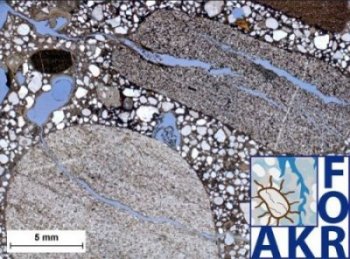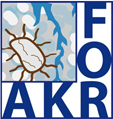Startseite

Schädigungen im Beton sind seit Jahrzehnten bekannt. In
umfangreichen bisherigen Untersuchungen bezüglich einer schädigenden
Alkali-Kieselsäure-Reaktion (AKR) im Beton wurde überwiegend der Fall einer sog.
internen Alkalizufuhr betrachtet, bei der die Alkalien ausschließlich über die
Betonausgangsstoffe von Haus aus in den Beton gelangten. In bestimmten Fällen
kommen im Laufe der Nutzung aber auch weitere Alkalien von außen hinzu, die die
AKR u.U. sogar stärker beeinflussen können als die internen Alkalien. Typische
Fälle hierfür sind Bauwerke mit Meerwassereinwirkung und Verkehrsflächen, auf
die alkalihaltige Taumittel aufgebracht werden. Bei Letzteren kommen noch
zusätzliche zyklische Verkehrsbeanspruchungen und Frost-Taumitteleffekte hinzu,
durch die sich zum einen im Betongefüge Mikrostörungen einstellen können
(Degradation), die das Eindringen der alkalihaltigen Medien in größere Tiefen
begünstigen, zum anderen der Eindringvorgang durch Einwalken noch intensiviert
wird.
Mit den in dieser Forschergruppe erzielten Ergebnissen soll primär das
Verständnis der maßgebenden Mechanismen vor und während einer AKR unter den
zugrunde gelegten kombinierten Einwirkungen verbessert werden. Darauf aufbauend
können die derzeitigen Unsicherheiten im gesamten Betonbau hinsichtlich AKR
entschärft und entsprechende Handwerkszeuge (Modelle) bereitgestellt werden.
Letztendliches Ziel ist es, daraus abgesicherte Regelungen für die Auswahl von
Betonausgangsstoffen, die Festlegung von Betonzusammensetzungen, die
Dimensionierung von Bauteilen, sowie besondere, einfach umzusetzende Maßnahmen
während der Nutzung abzuleiten.
Aktuelles
20. Internationale Baustofftagung ibausil in Weimar
"Forschergruppe 1498 stellt Ergebnisse der 2. Förderperiode geschlossen vor"

Vom 12.-14. September 2018 hat die 20. Internationale Baustofftagung ibausil in Weimar stattgefunden. Die Tagung war mit knapp 600 Teilnehmern aus 25 Ländern sehr gut besucht. Die Forschergruppe FOR 1498 konnte, wie auch schon 2015, ihre Ergebnisse der gesamten Förderzeit in einem Block der internationalen Fachöffentlichkeit präsentieren. Jedes Teilprojekt hat dabei die in Synergie mit den anderen Teilprojekten entstandenen Ergebnisse vorgetragen. Die Vorträge lauteten wie folgt:
Teilprojekt Z:
Breitenbücher, R.: AKR unter kombinierten Einwirkungen - Gesamtüberblick über die DFG-Forschergruppe FOR 1498
Vortrag TPZTeilprojekt 1:
Przondziono, R.; AKR unter kombinierten Einwirkungen - Wie beeinflussen zyklische Beanspruchungen die Degradation und den Alkalieintrag in Beton
Vortrag TP1Teilprojekt 3:
Iskhakov, T.: AKR unter kombinierten Einwirkungen - Mehrskalenmodellierung von AKR-induzierter Schädigung in Betonbauteilen
Vortrag TP3Teilprojekt 4:
Weise, F.: AKR unter kombinierten Einwirkungen - Rissbildungs- und Transportmechanismen
Vortrag TP4Teilprojekt 5:
Giebson, C.: AKR unter kombinierten Einwirkungen - Lösekinetik von Gesteinskörnungen
Vortrag TP5Teilprojekt 6:
Wiedmann, A.: AKR unter kombinierten Einwirkungen - Schadensrisiko und Schadensentwicklung in Betonfahrbahnen
Vortrag TP613th International Symposium on Concrete Roads & Deutsche Betonstraßentagung 2018
"AKR unter kombinierten Einwirkungen - Aktuelles aus Forschung und Entwicklung"
Vom 19.-22.06.2018 findet die Veranstaltung "13th International Symposium on Concrete Roads" gemeinsam mit der Deutschen Betonstraßentagung 2018 in Berlin statt. Aus der Forschergruppe FOR 1498 tragen Herr Dipl.-Ing. Andreas Wiedmann über neuste Forschungsergebnisse zur "Alkali-Silicia-Reaction in the municipal road construction" und Herr Robin Przondziono, M.Sc. zum Thema "Alkali-Silica-Reaction in concrete pavements considering traffic and de-icing agents" vor.
Weitere Informationen Sie unter folgendem Link:
13th International Symposium on Concrete RoadsInternational PhD-Symposium on October 5th and 6th in Bochum
"Alkali-Silica Reaction in Concrete Structures - Cyclic Loading, Fluid Transport and Modeling"
The DFG funded reserach group FOR 1498 hosted an international PhD-Symposium on October 5th and 6th in Bochum, Germany. A variety of national and international PhD-Candidates presented extracts of their current work in the broad field of ASR. After each presentation, the auditorium used the oportunity for an in-depth discussion and exchange of experience
Internationale Vorträge der FOR 1498
15th International Conference on Alkali-Aggregate Reaction, Sao Paolo, Brazil
July 3rd through July 7th
"Influence of simultaneous cyclic loading and external alkali supply on the alkali-silica reaction in concrete pavements"
Weise, Frank; Voland, Katja; Piskawetz, Stephan und Meng, Birgit
In recent years the German highway network has seen an increase in the occurrence of damage in concrete road surfaces which can be attributed to the alkali-silica reaction (ASR). In view of the often drastic reduction in life expectancy experienced by concrete pavements due to ASR, research activity in this field has notably increased. Until now the main research focus has been, alongside preventative measures in concrete technology, the development of performance-oriented testing procedures for ASR prevention. This included more specifically the accelerated simulation of climatic effects and external alkali supply on concrete pavements. The effects of pre-damage from the additionally interacting cyclic traffic loading had previously not been taken into consideration. Since 2011, a five-partner research group from the German Research Foundation has been pursuing research on the effects of simultaneous cyclic loading and external alkali supply on the destructive ASR in concrete pavements. The depiction of the myriad degradation and transport processes necessary for an understanding of these effects requires a close interaction between experiments and their multi-scale modelling. This contribution aims to focus on the aforementioned experiments by means of innovative testing techniques. The research is founded on a series of cyclic fatigue tests performed on large-format beams, both with and without previous application of a NaCl solution, with simultaneous tracking of crack development. Thereafter, smaller test specimens were extracted from the pre-damaged beams for further experiments. These included the spatial visualization and quantification of fatigue-induced cracks with X-ray 3D-computed tomography. Additionally, the effects of fatigue-induced cracks on moisture and alkali transport were investigated using 3D-CT and Laser-Induced Breakdown Spectroscopy (LIBS). Subsequent storage of the small-format test specimens, with and without cyclic pre-damage, in an ASR-conducive environment was then able to shed light on the influence of fatigue-induced pre-damage on the ASR.
11th International Conference on Conference Pavements, San Antonio, Texas, USA
August 27th through August 31st
"Degradation in pavement concretes - Effects of cyclic loading on fluid transport processes and ASR"
Przondziono, Robin und Breitenbücher, Rolf
The Alkali-Silica-Reaction (ASR) in concrete pavements has been known for several years. The previous investigations of ASR focused mainly on potentially reactive aggregates and the assessment of the ASR-potential in concrete pavements. A study of the separate influences causing and accelerating an ASR has been missing. The ASR can be greatly affected by externally supplied alkalis such as de-icing agents. These penetrate into the concrete microstructure, which is damaged through cyclic stresses caused by traffic, and thus it can possibly initiate or accelerate a damaging ASR. One focus within an extensive research project is the characterization of the degradation in the concrete microstructure caused by cyclic loading. Further focus lies on the determination of the effect of degradation on the transport behavior of fluids into the concrete under varying conditions. Within this research, two test setups were developed in order to efficiently test large-scale concrete beams simultaneously. The first test setup allows simultaneous cyclic testing of up to six beams in a 4-point flexural test under varying stress levels thus causing microstructural degradation. The second test setup provides a method to test six beams in circular array by overrolling them with a loaded tire while a solution with de-icing agents is on top the concretes surface. By the overrolling tire a penetration depth of the alkaline solution of about 2 to 4 cm deeper than without overrolling was determined. These studies show the degradation of the concrete microstructure under a varying number of load-cycles and changing stress levels. A significant increase in penetration depth of alkaline solutions was not only determined for different stages of degradation but also for the overrolling tire, which increases the pressure on the surface locally. The externally applied alkali-ions then increase and accelerate an ASR drastically. The effect of externally supplied alkalis becomes of great relevance for ASR.



